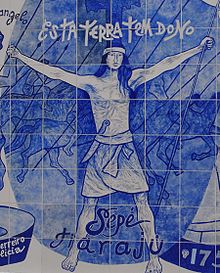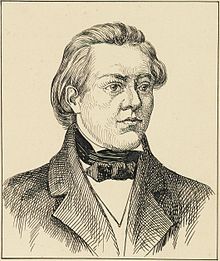Sepé Tiaraju

Sepé Tiaraju or José Sepé Tiarayú (* around 1720, in the reduction São Luiz Gonzaga or San Francisco de Borja; † February 7, 1756 in São Gabriel , in today's state of Rio Grande do Sul , Brazil ) was a leader of the Guaraní against Portuguese and Spanish associations in the Guerra Guaraníticas , the Guaraníkriegen that took place from 1753 to 1756. In the 19th century he became an important literary figure and the main character in an opera that is important to music history . Today he is held in high regard on both sides of the Brazilian-Argentine border, occasionally worshiping saints, and in November 2009 he was accepted into the ranks of the twelve national heroes of Brazil .
Life

In the Treaty of Madrid in 1750, the European powers agreed on the border between the Portuguese and Spanish parts of South America . For the Colonia del Sacramento or Banda Oriental , today Uruguay , which Portugal ceded to Spain, the Portuguese received the Misiones Orientales (Eastern Missions, today about the area of the Brazilian state Rio Grande do Sul ).
These mission stations, established by the Jesuits about a century earlier, were El Tapé, Los Siete Pueblos and Las Once. The 80,000 or so Guarani who lived in the mission stations east of this border, and thus on Brazilian territory, were to be resettled westwards. The new border should be Uruguay .
However, they were not willing to give up their villages, especially since they had become very successful ranchers, especially cattle and horses, and had one of the largest herds of cattle in Latin America. The Jesuits managed to delay the deportation for several years. In 1752 Tiaraju convened a gathering of 600 people with the Spanish military leaders in the oratory of Fuerte de Santa Tecla. At first only 68 men were available to him. But Sepé Tiaraju was soon captured. He escaped the day before his execution. The Guarani attacked the fortress of Santo Amaro (Fort Jesus, Maria, Jose de Río Pardo) in February 1753 and captured it after a month of siege.
In July 1754 a joint army of Portugal and Spain went against the Guarani. 2000 Spaniards and 1000 Portuguese marched from different directions against San Borja, the capital. After four months, most of the insurgents gave up, but Sepé Tiaraju allied themselves with the Charrúas and continued to resist. At the end of 1755 a second Portuguese-Spanish army broke out, but was embroiled in numerous skirmishes.
The war cry "Esta terra tem dono!" (This land has owners!) Is said to come from Sepé Tiaraju. He was killed three days before the Battle of Caiboate, on February 7, 1756. According to legend, Tiaraju was hit by a Portuguese lance and a Spanish bullet. It is unclear whether the bullet came from José Joaquín de Viana , the governor of Montevideo .
Nicolàs Neenguirú followed as Guarani leader , but his army fell into a trap on February 10th. In the battle of Caiboate, near today's San Gabriel, in the hill country south of the Yaqui, 1,500 Guarani were killed within an hour, but only three Spaniards and two Portuguese.
Few of the Indians were able to flee and continue the fight for several weeks.
Aftermath
In 1761, the provisions of the Treaty of Madrid were declared null and void. The area came back to Spain until 1800, but was conquered by Brazilian bandeirantes in 1801 . The Jesuits had been banned from the area since 1767 and the order was repealed in 1773. The Peace of Badajoz (1801) , which ended the Orange War , finally brought the area to Portugal until 1810. With the end of Portuguese colonial rule, it came to Brazil.

Sepé Tiaraju was made famous by the Brazilian writer Basílio da Gama , in his poems O Uraguay (1769) and O Lunar de Sepé . Since then, Tiaraju has appeared repeatedly as a literary figure, for example in O tempo eo vento by Érico Veríssimo . In 1857 the novel O Guarany by José de Alencar was published , which is considered to be one of the most important works of Romanticism . In 1870 Antônio Carlos Gomes made an opera that premiered at La Scala in Milan . The resistance of the Guarani to the evacuation of 1756 became better known outside the Spanish and Portuguese-speaking areas through the 1986 film Mission by Roland Joffé .
In February 2006 around 8 to 10,000 Indians, mainly Guarani, from Argentina, Bolivia , Brazil, Paraguay and Uruguay celebrated Sepé Tiaraju's 250th anniversary of death. On the occasion of this day, the Guarani, who are spread over five countries, want to unite more organizationally.
In November 2009, Tiaraju was entered in the Book of Brazilian Heroes, in which Emperor Pedro I, Deodoro da Fonseca , who overthrew Pedro II, as well as Joaquim Jose da Silva Xavier , who led a failed revolt against the Portuguese colonial power, Zumbi dos Palmares , the leader of a slave rebellion or Chico Mendes , who is considered the defender of the rainforest.
The city of São Sepé in Rio Grande do Sul, approx. 200 km west of Porto Alegre , is named after Sepé Tiaraju, who enjoys the status of a saint there. The ruins of the missions destroyed in the 1756 massacre are now a tourist attraction.
literature
- Alcy Cheuiche: Sepé Tiaraju - The last chief. Roman from Brazil , Erlanger Verlag für Mission und Ökumene 1997, ISBN 978-3-87214-271-9
Web links
- Sepé Tiaraju (Portuguese), archive.org, December 13, 2007
- Guarani Indians United, February 7, 2006 , archive.org, July 9, 2011
See also
Remarks
- ^ David Marley: Wars of the Americas: a Chronology of Armed Conflict in the New World, 1492 to the Present , Santa Barbara 1998, p. 274.
- ^ Carlos A. Moreno: Brazil Indian Who Battled Conquerors Recognized as National Hero , in: Latin American Herald Tribune
| personal data | |
|---|---|
| SURNAME | Tiaraju, Sepé |
| ALTERNATIVE NAMES | Tiarayú, José Sepé |
| BRIEF DESCRIPTION | Guarani leaders in the fight against the forced relocation agreed by Portugal and Spain |
| DATE OF BIRTH | around 1720 |
| PLACE OF BIRTH | São Luiz Gonzaga, Rio Grande do Sul |
| DATE OF DEATH | February 7, 1756 |
| Place of death | Sao Gabriel |
